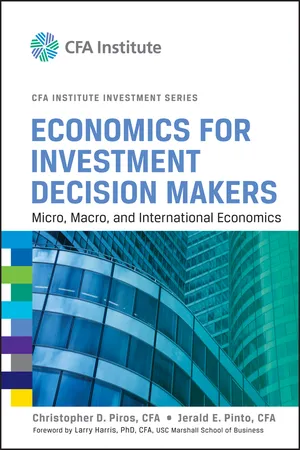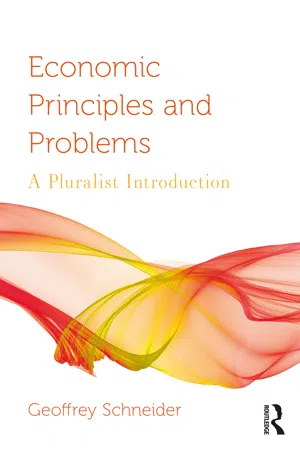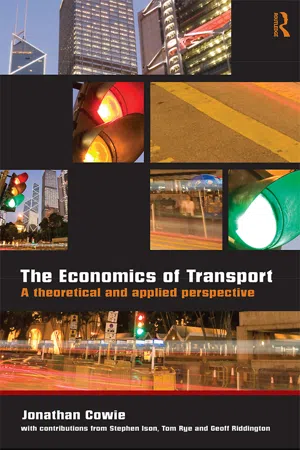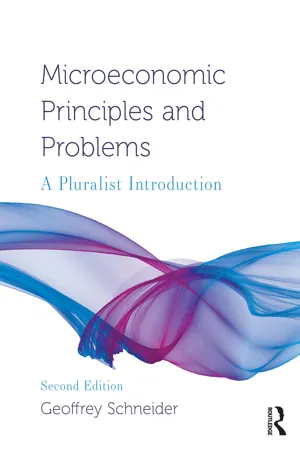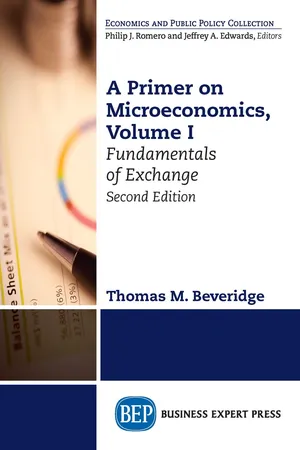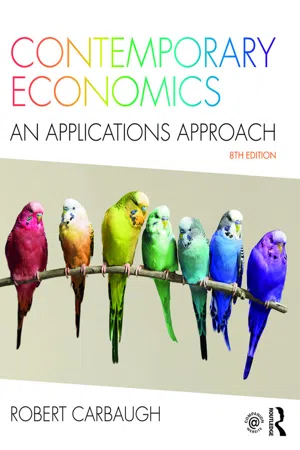Economics
Cross Elasticity of Demand
Cross Elasticity of Demand measures the responsiveness of the quantity demanded of one good to a change in the price of another good. It helps to determine whether two goods are substitutes or complements. A positive cross elasticity indicates that the goods are substitutes, while a negative cross elasticity suggests that the goods are complements.
Written by Perlego with AI-assistance
Related key terms
11 Key excerpts on "Cross Elasticity of Demand"
- eBook - ePub
Economics for Investment Decision Makers
Micro, Macro, and International Economics
- Christopher D. Piros, Jerald E. Pinto(Authors)
- 2013(Publication Date)
- Wiley(Publisher)
That elasticity is called the cross-price elasticity of demand and takes on the same structure as own-price elasticity and income elasticity of demand, as represented in Equation 1-26. (1-26) Note how similar in structure this equation is to own-price elasticity. The only difference is that the subscript on P is now y, indicating the price of some other good, Y, instead of the own-price, X. This cross-price elasticity of demand measures how sensitive the demand for good X is to changes in the price of some other good, Y, holding all other things constant. For some pairs of goods, X and Y, when the price of Y rises, more of good X is demanded. That is, the cross-price elasticity of demand is positive. Those goods are defined to be substitutes. Substitutes are defined empirically. If the cross-price elasticity of two goods is positive, they are substitutes, irrespective of whether someone would consider them similar. This concept is intuitive if you think about two goods that are seen to be close substitutes, perhaps like two brands of beer. When the price of one of your favorite brands of beer rises, what would you do? You would probably buy less of that brand and more of one of the cheaper brands, so the cross-price elasticity of demand would be positive. Alternatively, two goods whose cross-price elasticity of demand is negative are defined to be complements. Typically, these goods would tend to be consumed together as a pair, such as gasoline and automobiles or houses and furniture. When automobile prices fall, we might expect the quantity of autos demanded to rise, and thus we might expect to see a rise in the demand for gasoline. Ultimately, though, whether two goods are substitutes or complements is an empirical question answered solely by observation and statistical analysis. If, when the price of one good rises, the demand for the other good also rises, they are substitutes. If the demand for that other good falls, they are complements - eBook - ePub
Economic Principles and Problems
A Pluralist Introduction
- Geoffrey Schneider(Author)
- 2021(Publication Date)
- Routledge(Publisher)
< 0. People buy less of these goods when their incomes increase. Examples of inferior goods include margarine, rice, flour, and public transportation. Think about what goods you would stop buying if you had a lot more money than you do now. These are inferior goods to you.10.7.2 Cross-price elasticity of demand
Cross-price elasticity of demand measures the responsiveness of the quantity demanded of one good to the price of a different good. Specifically, the formula for cross-price elasticity, e xy , is:e=x y=Percentage change in quantity demanded of good xPercentage change in the price of good y.% ΔQd x% ΔP yEconomists use cross-price elasticity of demand to measure the closeness of substitutes and complements. A substitute good has a cross-price elasticity that is greater than 0: e xy > 0. When the price of Coca-Cola increases, the quantity of Pepsi, a close substitute, demanded increases. A higher price for Coca-Cola causes consumers to buy less Coke and more Pepsi. For example, a 10% increase in the price of Coca-Cola typically causes a 6% increase in the quantity of Pepsi demanded. From this information, we can compute a cross-price elasticity of Pepsi relative to the price of Coca-Cola of
Similarly, whole-fat and low-fat milk have a cross-price elasticity of 0.5. The larger the cross-price elasticity, the closer the substitute.e=Pepsi − Coke= 0 .6 .6%10%A complementary good has a cross-price elasticity of less than 0: e xy < 0. When the price of a good increases, consumers buy less of that good and less of any complementary goods. For example, when the price of gasoline goes up, consumers reduce their purchases of gasoline and very large SUVs. A 10% increase in the price of gasoline (P Gas ) causes a 3% decrease in the quantity of large SUVs demanded (Q d SUVs ), giving SUVs a cross-price elasticity e SUVs-Gas - eBook - ePub
- Andrew Barkley, Paul W. Barkley(Authors)
- 2016(Publication Date)
- Routledge(Publisher)
This formula states that the cross-price elasticity of demand is the percentage change in quantity demanded of good Y 2 given a one percent change in price of good Y 1. If two goods Y 1 and Y 2 are unrelated, then the change in the price of Y 1 has no effect on the consumption of good Y 2, and the cross-price elasticity is equal to zero (E d Y1Y2). There are two types of related goods in consumption: Substitutes and Complements. Substitutes in Consumption = goods that are consumed on an “either/or” basis, such as wheat bread and white bread. Corn and milo (sometimes called “grain sorghum”) are substitutes in consumption for feeding cattle. A feedlot operator can purchase either of these two feed grains, since they are nearly equivalent nutritionally. If the price of corn increases, then the demand for milo increases, as feedlots substitute out of corn and into milo. Thus, the cross-price elasticity of demand is positive for substitutes. (9.17) E d Y1Y2 = %ΔQ d Y2 /%ΔP Y1 > 0. Electric appliances (stoves, furnaces, and hot water heaters), and natural gas appliances are frequently substitutes. Most homes in the northern United States have either gas or electric appliances (sometimes both), depending on the relative prices of natural gas and electricity. Within some limits, gasoline and bicycles are substitutes. As the price of gasoline rises, short-distance commuters switch to bicycles. Complements in Consumption are goods consumed together, for example bread and butter, or biscuits and gravy, or dress shirts and neckties. Complements in Consumption = goods that are consumed together, such as peanut butter and jelly. Plate 9.6 Peanut butter and jelly If the price of bread increases, consumers will purchase less bread, and as a consequence they need less butter. The demand for butter decreases when the price of bread increases - eBook - ePub
The Economics of Transport
A Theoretical and Applied Perspective
- Jonathan Cowie(Author)
- 2009(Publication Date)
- Routledge(Publisher)
As a negative value is being divided by a positive, this produces a negative figure. Thus for complementary transport services, cross price elasticity will always be negative. As the price of one service rises, demand for the complementary good or service will decrease and vice-versa. Again the higher the negative value, the more the two goods are interdependent. Where the value is around zero however, this indicates that the two goods are completely independent, i.e. neither substitutes nor complements.Figure 4.9Cross price elasticity of demand, complementsTo summarise, cross price elasticity of demand measures the interdependence of two modes of transport or services. Where this is positive, these are substitute services, with higher values indicating closer substitutability between the two modes being examined. Note also that this partly ties in with own price elasticity of demand, as other things being equal, if two products have a high cross price elasticity of demand then by implication own price elasticity should be highly elastic. This is because each of these services has a very close substitute available, which was the first determinant of price elasticity of demand examined. Complementary goods on the other hand will produce negative cross price elasticities, as these goods/services are consumed at the same time, thus a rise in the price of one will produce a decrease in the demand for the other.Case study 4.2 Issues in cross price elasticity of demandThis case study takes a closer look at cross price elasticity and highlights a number of important issues surrounding the topic. It uses three research studies into cross price elasticity to illustrate these ideas, although many others exist. This should allow us to explore the topic further and as we will see, whilst the equation for cross price elasticity may appear to be fairly straightforward, working with some real life examples should help to bring certain aspects into perspective. We begin with Oum et al.’s (1990) review of around 70 studies relating to both passenger and freight transport with regard to both own and cross price elasticities. Here we are only concerned with cross price elasticity, thus a summary of the results of two of the studies examined, with the first set concerning freight presented in Table 4.3 - eBook - ePub
Microeconomic Principles and Problems
A Pluralist Introduction
- Geoffrey Schneider(Author)
- 2024(Publication Date)
- Routledge(Publisher)
xy , is:e=x y=p e r c e n t a g e c h a n g e i n q u a n t i t y d e m a n d e d o f g o o d xp e r c e n t a g e c h a n g e i n t h e p r i c e o f g o o d y.% ▵QD x% ▵P yEconomists use cross-price elasticity of demand to measure the closeness of substitutes and complements. A substitute good has a cross-price elasticity that is greater than 0: exy > 0. When the price of Coca-Cola increases, the quantity of Pepsi demanded, a close substitute, increases. A higher price for Coca-Cola causes consumers to buy less Coke and more Pepsi. For example a 10% increase in the price of Coca-Cola typically causes a 6% increase in the quantity of Pepsi demanded. From this information, we can compute a cross-price elasticity of Pepsi relative to the price of Coca-Cola of:Similarly, whole fat and low-fat milk have a cross-price elasticity of 0.5. The larger the cross-price elasticity, the closer the substitute.e=P e p s i − C o k e= 0 . 6 .6 %10 %A complementary good has a cross-price elasticity of less than 0: exy < 0. When the price of a good increases, consumers buy less of that good and less of any complementary goods. For example, when the price of gasoline goes up, consumers reduce their purchases of gasoline and very large SUVs. A 10% increase in the price of gasoline (PGas ) causes a 3% decrease in the quantity of large SUVs demanded (QD SUVs ), giving SUVs a cross-price elasticity eSUVs–Gas = −0.3. Similarly, meat and potatoes are complements for many consumers, with a cross-price elasticity of −0.2.We also find goods that are neither substitutes nor complements for each other, in which case the cross-price elasticity is 0. The price of Coca-Cola has no impact on the demand for iPhones, so eCoke-iPhones - Peter Davis, Eliana Garcés(Authors)
- 2009(Publication Date)
- Princeton University Press(Publisher)
Demand at a particular price point is considered “elastic” when the elasticity is bigger than 1 in absolute value. An elastic demand implies that the change in quantity following a price increase will be larger in percentage terms so that revenues for a seller will fall all else equal. An inelastic demand at a particular price level refers to an elasticity of less than 1 in absolute value and means that a seller could raise revenues by increasing the price provided again that everything else remained the same. The elasticity will generally be dependent on the price level. For this reason, it does not usually makes sense to talk about a given product having an “elastic demand” or an “inelastic demand” but it should be said that it has an “elastic” or “inelastic” demand at a particular price or volume level, e.g., at current prices. The elasticities calculated for an aggregate demand are the market elasticities for a given product.1.1.2.2 Substitutes and Complements
The cross-price elasticity of demand expresses the effect of a change in price of some other good k on the demand for good j . A new, higher, price forpkmay, for instance, induce some consumers to change their purchases of product j . If consumers increase their purchases of product j whenpkgoes up, we will call products j and k demand substitutes or just substitutes for short.Two DVD players of different brands are substitutes if the demand for one of them falls as the price of the other decreases because people switch across to the now relatively cheaper DVD player. Similarly, a decrease in prices of air travel may reduce the demand for train trips, holding the price of train trips constant.On the other hand, the new higher price of k may induce consumers to buy less of good j . For example, if the price of ski passes increases, perhaps fewer folk want to go skiing and so the demand for skiing gear goes down. Similarly, if the price of cars increases, the demand for gasoline may well fall. When this happens we will call products j and k demand complements or just complements for short. In this case, the customer’s valuation of good j increases when good k has been purchased:81.1.2.3 Short Term versus Long Term
Most demand functions are static demand functions—they consider how consumers allocate their demand across products at a given point in time. In general, particularly in markets for durable goods, or goods which are storable, we will expect to have important intertemporal linkages in demand. The demand for cars today may depend on tomorrow’s price as well as today’s price. If so, demand elasticities in the long run may well be different from the demand elasticities in the short run. In some cases the price elasticity of demand will be higher in the short run. This happens for instance when there is a temporary decrease in prices such as a sale, when consumers will want to take advantage of the temporarily better prices to stock up, increasing the demand in the short run but decreasing it at a later stage (see, for example, Hendel and Nevo 2006a,b). In this case, the elasticity measured over a short period of time would overestimate the actual elasticity in the long run. The opposite can also occur, so that the long-run elasticity at a given price is higher than the short-run elasticity. For instance, the demand for petrol is fairly inelastic in the short run, since people have already invested in their cars and need to get to work. On the other hand, in the long run people can adjust to higher petrol prices by downsizing their car.- eBook - ePub
A Primer on Microeconomics, Second Edition, Volume I
Fundamentals of Exchange
- Thomas M. Beveridge(Author)
- 2018(Publication Date)
- Business Expert Press(Publisher)
: Many states have introduced lotteries. One argument against lotteries is that they act like a tax (albeit a voluntary one), and that poor citizens tend to be taxed more. If so, then lotteries may be thought of a form of regressive taxation. A study showed that the income elasticity of demand for lottery tickets was –0.1. Does this evidence lend support to the objection that lottery tickets are a method of regressive taxation?Cross-Price Elasticity of DemandCross-price elasticity of demand (Xd ) measures the degree by which the demand for one good changes when the price of a related good changes. In Chapter 2 , we learned that if the price of Good B increases, then the demand for a substitute Good A will increase—there is a positive relationship between “percentage change in the price of Good B” and “percentage change in the demand for Good A” when the goods are substitutes. If the price of Coca-Cola increases (+ ), then consumer demand for Pepsi will increase (+ ). By contrast, the relationship will be negative in the case of complements. If the price of beer increases (+ ), then consumer demand for beer nuts will decrease (− ). If goods are independent, the elasticity value will be zero.Our intuitive formula would look like this:XdAB = percentage change in demand for Good A/percentage change in price of Good B. This could be expressed the following way:XdAB = %ΔDA /%ΔPBTHINK IT THROUGH: We know that two goods that are substitutes will have a positive cross-price elasticity. Coke and Pepsi are such goods, but so are Coke and Sprite. However, Coke and Sprite are less close substitutes than are Coke and Pepsi. Will the cross-price elasticity coefficient between Coke and Sprite be higher than or lower than that between Coke and Pepsi? (The answer follows!)Figure 4.5 summarizes what we have learned about cross-price elasticity of demand.The cross-price elasticity relationship between Coke and Pepsi is estimated to be about + - eBook - ePub
- Rob Dransfield(Author)
- 2013(Publication Date)
- Routledge(Publisher)
Price elasticity of demand – measures the percentage change in quantity demanded caused by a percentage change in price. As such, it measures the extent of movement along the demand curve.Price elasticity of supply – measures how the amount of a good firms wish to supply changes in response to a change in price. Price elasticity of supply captures the extent of movement along the supply curve.In the analysis that follows we will first review elasticity of demand before going on to examine elasticity of supply. Business managers are particularly interested in the extent to which demand is likely to respond to a price change. Measuring the response is referred to as the measurement of price elasticity. In addition, it is helpful to measure the responsiveness of demand to variables other than price – for example:- The responsiveness of demand for a good to changes in the prices of other goods – referred to by economists as cross-price elasticity.
- The responsiveness of demand for a good to changes in income – referred to by economists as income elasticity.
A restaurant owner who is considering increasing prices will first want to know what teffect this will have on the customers. Will there be no effect, a small fall in customers, or a large fall? If the number of customers remains the same or falls by a smaller percentage than the price change, the business will make more revenue. The calculation used to estimate this effect is price elasticity of demand, which measures how quantity demanded for a product responds to a change in its price. Anyone wishing to raise or lower prices should first estimate the price elasticity.Measuring price elasticity Key TermPrice elasticity - eBook - ePub
- William G. Tomek, Harry M. Kaiser(Authors)
- 2014(Publication Date)
- Cornell University Press(Publisher)
With our current state of knowledge, empirical results must be judged relative to their intended use and cannot be judged relative to some absolute standard of correctness. 7 Total Elasticity The own-price elasticity of demand provides a measure of the percentage change in quantity demanded in response to a 1 percent change in price, other factors held constant. As such, it is a partial measure of the change in quantity demanded, since other factors are not allowed to change. However, if the price of one good changes, the prices of other goods, especially substitutes, will change as well, at least in competitive markets. The prices of substitutes tend to move in the same direction, but by varying amounts. A change in the price of one product sets in motion changes in other prices and quantities that ultimately result in a new structure of prices. For example, if the price of beef declines, the demand for its substitutes (e.g., pork) also declines. Given a fixed supply of pork, the price of pork decreases, and the change in the price of pork will, in turn, influence the demand for (and hence the price of) beef. Consequently, one needs to consider more than the partial own-price elasticity of demand for beef to estimate the net final effect on the consumption of beef of a change in the price of beef. The foregoing discussion assumes a very short-run situation in which supplies are constant. The relationship becomes even more complex if one takes account of the possible effects of changes in the relative prices of competing commodities on quantities supplied. To predict the total effect of one initial price change, a complete knowledge of all own-price and cross-price elasticities of demand and supply is required. Such knowledge could come from what are called, in econometrics, the structural supply and demand equations - eBook - ePub
Micro Markets Workbook
A Market Structure Approach to Microeconomic Analysis
- Robert A. Schwartz, Michael G. Carew, Tatiana Maksimenko(Authors)
- 2010(Publication Date)
- Wiley(Publisher)
8. We concluded the chapter with the thought that, in the frictionless environment, it is not portfolios or individual shares that are priced, it is risk that is priced. But one does not buy risk. Rather, the market pays a participant for accepting it. In the perfect, frictionless environment, perfect substitutes exist for every individual stock, and the market’s demand curve to hold shares of each stock in the market portfolio is infinitely elastic at a price that depends on the stock’s covariance with the market. This is because only systematic (as distinct from diversifiable) risk is priced (diversifiable risk can be reduced to nil by sufficient portfolio diversification), and a stock’s covariance with the market measures the stock’s systematic risk, which is the stock’s contribution to the riskiness of the market portfolio (our risky asset).GLOSSARY
complements Products that are consumed in combination with each other. If X and Y are complements, the Cross Elasticity of Demand for X with respect to the price of Y is negative. Tennis rackets and tennis balls are complements. With perfect complements, X and Y are consumed in fixed proportions regardless of their relative prices.covariance with the market A measure of how the rate of return for an asset varies with the rate of return on the market portfolio.cross price elasticity The percentage in the quantity demanded or supplied of a good or service divided by the percentage change in another product’s price, all else constant.diversifiable risk The portion of the total returns variance for an asset that can be eliminated by portfolio diversification.income elasticity of demand The percentage change in quantity for a good or service divided by the percentage change in a consumer’s income, all else constant.income expansion path For a two good model (e.g., X and Y), the locus of optimality points in X, Y space achieved by a consumer for different values of the consumer’s income, the prices of X and of Y - Available until 20 Jul |Learn more
Contemporary Economics
An Applications Approach
- Robert Carbaugh(Author)
- 2016(Publication Date)
- Routledge(Publisher)
This is because price and quantity demanded are inversely related according to the law of demand. In our example, the increase in ticket prices causes the numerator in the formula to be positive (+10 percent), while the decrease in game attendance causes the denominator to be negative (−5 percent). As a result, E d will have a negative value. By convention, economists drop the negative sign when calculating the price elasticity of demand, realizing that price and quantity demanded move in opposite directions. Depending on the response of buyers to a change in price, demand is characterized as elastic, inelastic, or unit elastic. Elastic. Demand is elastic when the percentage change in quantity demanded is greater than the percentage change in price, meaning that E d is greater than 1. Example: A 20-percent reduction in the price of Pepsi causes a 30-percent increase in the quantity demanded. Specifically, E d is 1.5 in this case (30 / 20 = 1.5). Inelastic. Demand is inelastic when the percentage change in quantity demanded is less than the percentage change in price, meaning that E d is less than 1. Example: A 30-percent increase in the price of Levi’s jeans causes a 10-percent decrease in quantity demanded. Specifically, E d is 0.33 in this case (10 / 30 = 0.33). Unit elastic. Demand is unit elastic when the percentage change in quantity demanded equals the percentage change in price, meaning that E d equals 1.0. Example: An 8-percent decrease in the price of Timex watches causes an 8-percent increase in the quantity demanded (8 / 8 = 1.0). Table 3.1 reports the estimated price elasticities of demand for selected products. When making such estimates, economists distinguish between a period during which consumers have little time to adjust (the short run) and periods during which consumers have time to fully adjust to a price change (the long run)
Learn about this page
Index pages curate the most relevant extracts from our library of academic textbooks. They’ve been created using an in-house natural language model (NLM), each adding context and meaning to key research topics.
